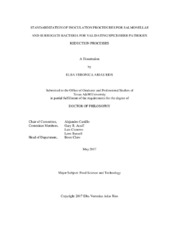| dc.description.abstract | Suitable spice inoculation procedures using surrogates of Salmonella are needed to perform adequate validations of spice disinfection processes. In this study, inoculation procedures of dried oregano and onion powder (OP) were developed and standardized using Salmonella, and Pediococcus faecium, as a potential surrogate. The effectiveness of traditional liquid inoculation was compared with dry inoculation of spices using silica and talcum powder (as inert vehicles for the microorganisms). A small amount of inoculated OP was used as starter for inoculation of larger bathes of OP. The stability of the inoculated microorganisms was monitored over time at -18, 4, and 25 °C.
Salmonella strains isolated from outbreaks associated with spices (SRSS) and nonassociated with spices (non-SRSS) were evaluated to determine their appropriateness to represent the most resistant pathogenic strains during spice desiccation processes.
For dry oregano, the final concentrations of SRSS, non-SRSS, and P. faecium were 5.5, 3.6, and 4.2 log CFU/g, respectively, when using a liquid inoculation. When removing 18% of the oregano’s EO, the concentration of SRSS, non-SRSS, and P. faecium increased to 7.2, 5.1, and 6.4. log CFU/g, respectively; and when removing 58% of the oregano’s EO, the final counts were 7.0, 5.6, and 7.2 log CFU/g, respectively. Dry inoculation of oregano using pre-inoculated inert powders yielded in silica: 6.7, 5.0, and 6.9 CFU/g, and in talcum: 6.0, < 3, and 7.8 log CFU/g of SRSS, non-SRSS, and P. faecium, respectively.
For OP, liquid inoculation was not successful since the consistency changed from powdery to clumpy and sticky. However, the OP consistency was maintained when iii inoculating in a 1:50 v/w (inocula/OP) ratio. After desiccation, SRSS, non-SRSS, and P. faecium had a reduction of 0.7, 0.8, and 0.0 log CFU/g of SRSS, non-SRSS, and P. faecium.
The SRSS showed higher resistance to desiccation than the non-SRSS, whereas P. faecium showed the greatest resistance between the 3 groups of microorganisms.
In general, all microorganisms were more stable at -18 and 4 °C than at 25 °C during storage independently of the matrix tested | en |


